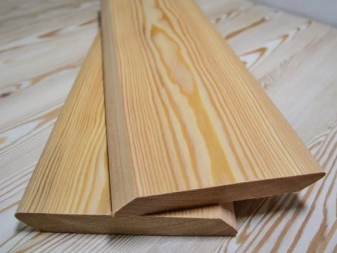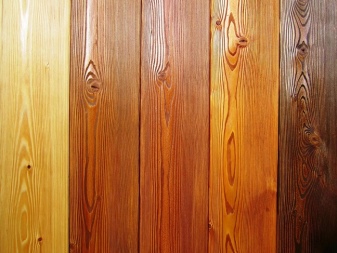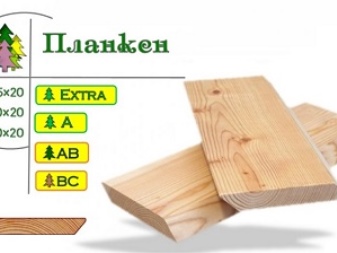Varieties and installation of larch planken

Larch plank is a facade finishing material that is successfully gaining popularity from the lining and block house. The parameters of these thin strips 140 × 20 and other sizes allow you to obtain decorative cladding that looks respectable and reliable. The varieties of planken from Siberian larch - beveled and straight, brushed and dyed - differ not only in appearance. They can relate to different types of products, which significantly affects the purpose of the material.


Features and scope
Larch plank is a finishing material in the form of thin boards with a sanded surface and a special edge treatment. Environmentally friendly natural wood is suitable for creating wall cladding, ceilings in the interior. Planken can be laid on the floor as a finishing coating instead of parquet boards, but the presence of irregularities and bevels at the edges should be taken into account. However, it looks most interesting of all when sheathing houses.
Such a facade board does not adhere tightly to the wall, providing a natural formation of the ventilation gap. A beautiful pattern of solid larch looks aesthetically pleasing and noble.
Such a facade can not even be tinted, while retaining the natural texture and texture of the wood. This is an obvious advantage over the many options for siding and other imitation materials.



It is worth mentioning the main features of larch planken.
- Thermal resistance. Well-processed wood tolerates both winter frosts and direct heating by the rays of the sun without visible problems, retaining its properties and geometric parameters.
- Excellent strength characteristics. In the production of planken, only the densest part of the tree is used. Over time, the finish gains additional strength.
- Biological resistance. The material has the ability to resist the development of mold and mildew, it has enough resin to eliminate the need for antiseptic surface treatment.
- Increased moisture resistance. Wood does not absorb water, which allows it to resist rotting when finishing the surface of facades.
Thanks to these qualities, as well as aesthetics, larch planken is becoming an increasingly popular type of facade and interior decoration.


Species overview
Well-dried planken is prepared by processing in special chambers, then polished. This is how the classic version looks like, which retains all the features of Siberian larch. The surface of the planken can be varnished or impregnated, if desired, tinted. Brushed larch plank is subjected to additional processing. The material is artificially aged - in classical technology, rigid metal brushes are used for this, hence the name.


On an industrial scale, brushing is carried out using sandblasting equipment, abrasive equipment. After firing and removing some of the fibers, the structure of natural larch becomes smooth, its pattern appears clearer and brighter. All that remains is to apply wax or oil to its outer part, which will emphasize the beauty of the wooden plank and protect it from contamination. By the type of edge processing, planken also has a division into oblique and straight options. Different types of profiles have their own characteristics.


Direct
The edges of the panel are slightly rounded, at the base they are located at right angles. It is a versatile option, well suited for interior decoration or exterior wall cladding. The material can be positioned horizontally and vertically, creating an interesting finish pattern, making it more varied.


Beveled
The oblique larch plank has cut edges on the sides. Their angle is 60 degrees. This option is optimal for cladding the facades of buildings. It is placed horizontally while maintaining an attractive finish pattern.


Varieties
Classification is also traditional for planken. Since this type of lumber is classified as expensive, the culling is always quite strict. The division is made into several varieties.
- "Extra". The most upscale kind of materials. Differs in impeccable surface cleanliness, any defects are not allowed in the structure. It is an elite material that is durable, dense and aesthetically pleasing and meets the highest aesthetic requirements.
- A or Prima. This grade has high requirements for the level of quality and purity of the material. Defectiveness includes the presence of more than 2 knots per running meter of material, individual pitching. Planken "Prima" is distinguished by an excellent pattern of the outer surface, it can be used to decorate respectable interiors.
- AB or B. Material of the middle price category. Planken can have inclusions in the form of small knots, cracks of a non-continuous nature, small defects on the edges of the panels. They should not be located in open, well-visible places. It is a good choice for finishing the facades of residential buildings or cladding interior walls, finishing window slopes and eaves.
- BC or just C. The most affordable planken variety, it is considered budgetary, but with a fairly high level of quality. Defects in the thickness of the wood may include knots, both small and large, chips on the edge, resin pockets, cracks. Such planken is suitable for performing household work, sheathing sheds, creating fences and interior decoration of auxiliary, non-ceremonial premises.
The grade of planken directly affects the cost of the material, its aesthetic and strength characteristics. That is why, when choosing it, it is important to pay attention to this indicator.



Dimensions (edit)
The standard dimensional parameters of larch planken are quite stable. The thickness is always 20 mm, the length can be from 2 to 5 m. The width of each strip is 9-14 cm. Most often, the marking looks like: 140X20 mm. This size range allows to obtain a sufficiently aesthetic facade coating, applies to all product classes.


Mounting methods
There are several ways in which you can fix larch plank. Different techniques are used depending on whether you are doing hidden or visible editing. The most common mounting options are most often used.
- For decorative nails. The method is suitable for fixing beveled planks, there are 2 nails for each board, but such a sheathing cannot be called durable. Rather, it can be considered decorative.
- Overlap. This attachment technology is well suited to work with the straight type of planken. The consumption of boards increases, but such wall cladding looks very attractive. A distinctive feature can be called a hidden type of installation - nails are hammered exclusively along the upper edge of each panel.
- In an open way. Fixing planks horizontally or vertically using ordinary nails, screws is used to create fences, wall cladding for painting or further decoration. This is a good solution for a simple and practical decoration of a summer cottage outside and inside. The choice of nails or screws as fasteners depends on whether the place of their installation will be closed or not.
- In a hidden way. In this case, a special type of fastener is used, which is fixed exclusively on the back of the panel. Its counterpart is fixed on the surface of the facade. There are several options for such fasteners at once.
It is not customary to mix larch planken with each other if it has different types of edges. The easiest way of placement is end-to-end, suitable for facades, requires the use of a main wall or lathing at the bottom.



Mounting options
The basic fixtures used for fixing the planks are also suitable for tongue-and-groove facades. When choosing suitable mounting elements, it is important to consider the type of finishing board - straight or oblique. The most commonly used types of mounts are presented below.
- "Bridge". Looks like a plate with "tendrils" on the sides. Fastened to the surface of the crate with self-tapping screws or screws. The bar is inserted into the gap between the "mustache", securely fixed and does not move during operation. This type of fastener is considered to be universal.
- "Snake". Mounting in the form of a metal strip with holes and projections, suitable for beveled planks. Fixed on the surface of each board, when joined in a row, helps to form a wave. The "snake" is attached to the crate with self-tapping screws, so it is very important to adhere to the edge of the plank when positioning it. The advantage of this fastener is the presence of a flange, which facilitates the formation of the correct ventilation gap.
- "Planfix". Fasteners installed on the side of the battens. The boards of the upper and lower row are additionally fixed with nails. The planfix itself is a metal plate with a spike and a right-angle bend. The advantage of this type of mounts is the reliable installation of the strips, without displacement and gaps.



The installation of an oblique plank has its own characteristics. Beveled hardwood planks require a preliminary sheathing arrangement. After it is mounted, you can start fixing the boards in an open or closed way. The first option is simpler, more convenient to repair or replace individual elements. If you want to get an aesthetic result, a snake mount is taken, and then hidden installation is performed. All elements must be hung out according to the level.
The step between the fastening of the "snake" on the plank should correspond to the frequency of the lathing. It is mounted across the facade board. The remaining edge of the metal product, when fastened, is removed under the lower board, and mounted on a self-tapping screw. Installing a straight planken is not difficult. The most common use is butt assembly using self-tapping screws. The mount turns out to be open, you can choose the option with a decorative hat or install plugs.
The best option for installation will be "planfix", which greatly facilitates the work of the wizard.

When installing, it is important to remember the simple rules that are relevant for all types of planken.
- Select fasteners carefully. It must meet the established requirements for strength and performance, fit the dimensions of the slats.
- Make the sheathing step smaller. When fastened in a vertical plane, this will reduce the likelihood of deformation of the facing material over time.
- Provide ventilation gaps. They are necessary for natural wood to prevent rotting, swelling under the influence of atmospheric moisture.
- Think over the styling pattern. Even horizontal or vertical orientation will look different. Beveled views are attached only longitudinally.
- Take care of thermal insulation and wind protection. The facade will be blown out if you do not install a layer of special materials.
All these tips will help you better understand the peculiarities of laying planken, and will facilitate the task directly during installation work.


How to cover?
The choice of a composition for painting or processing larch planken requires special attention. Professionals recommend using tinting mixtures with a transparent structure so as not to hide the beauty of the natural wood pattern. But if you want to get exactly the painted version of the facade board, you should process the material before attaching it to the wall. Each element is coated separately, in several layers. Opaque paints and varnishes have a great advantage over others in terms of durability.
As for the classical method, it includes a multi-stage combination of primer, color impregnation, intermediate sanding and application of a finishing decorative coating, most often it is a matte or glossy alkyd-based varnish.


It is important that the binder and solvent, as well as all formulations used, have the same base. Do not first apply water-soluble primer, but lay organic impregnation on top of it.
In general, aqueous compositions are generally not suitable for larch, since its resinous structure and organic salts contained in the wood react with this substance, causing the decorative finish to peel off and stains. If the planken is initially not very uniform in color, you should not choose transparent coatings - under the varnish, this difference will become even more obvious. Such material is coated with paints, it is also better to take an alkyd composition, on an organic basis.

In the next video, you can take a look at the larch planken on the combined facade.












The comment was sent successfully.